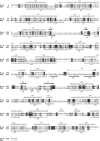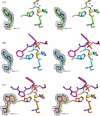The exquisite structure and reaction mechanism of bacterial Pz-peptidase A toward collagenous peptides: X-ray crystallographic structure analysis of PZ-peptidase a reveals differences from mammalian thimet oligopeptidase
- PMID: 20817732
- PMCID: PMC2966111
- DOI: 10.1074/jbc.M110.141838
The exquisite structure and reaction mechanism of bacterial Pz-peptidase A toward collagenous peptides: X-ray crystallographic structure analysis of PZ-peptidase a reveals differences from mammalian thimet oligopeptidase
Abstract
Pz-peptidase A, from the thermophilic bacterium Geobacillus collagenovorans MO-1, hydrolyzes a synthetic peptide substrate, 4-phenylazobenzyloxycarbonyl-Pro-Leu-Gly-Pro-D-Arg (Pz-PLGPR), which contains a collagen-specific tripeptide sequence, -Gly-Pro-X-, but does not act on collagen proteins themselves. The mammalian enzyme, thimet oligopeptidase (TOP), which has comparable functions with bacterial Pz-peptidases but limited identity at the primary sequence level, has recently been subjected to x-ray crystallographic analysis; however, no crystal structure has yet been reported for complexes of TOP with substrate analogues. Here, we report crystallization of recombinant Pz-peptidase A in complex with two phosphinic peptide inhibitors (PPIs) that also function as inhibitors of TOP and determination of the crystal structure of these complexes at 1.80-2.00 Å resolution. The most striking difference between Pz-peptidase A and TOP is that there is no channel running the length of bacterial protein. Whereas the structure of TOP resembles an open bivalve, that of Pz-peptidase A is closed and globular. This suggests that collagenous peptide substrates enter the tunnel at the top gateway of the closed Pz-peptidase A molecule, and reactant peptides are released from the bottom gateway after cleavage at the active site located in the center of the tunnel. One of the two PPIs, PPI-2, which contains the collagen-specific sequence, helped to clarify the exquisite structure and reaction mechanism of Pz-peptidase A toward collagenous peptides. This study describes the mode of substrate binding and its implication for the mammalian enzymes.
Figures







References
-
- Nimni M. E. (1983) Semin. Arthritis Rheum. 13, 1–86 - PubMed
-
- Suzuki Y., Tsujimoto Y., Matsui H., Watanabe K. (2006) J. Biosci. Bioeng. 102, 73–81 - PubMed
-
- Linsenmayer T. F. (1991) in Cell Biology of Extracellular Matrix (Hay E. D. ed.) pp. 7–44, Plenum Press, New York
-
- Myers L. K., Tang B., Rosloniec E. F., Stuart J. M., Chiang T. M., Kang A. H. (1998) J. Immunol. 161, 3589–3595 - PubMed
Publication types
MeSH terms
Substances
Associated data
- Actions
- Actions
- Actions
LinkOut - more resources
Full Text Sources

